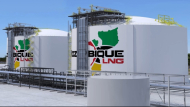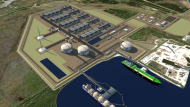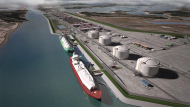Banks and investors’ unrestricted finance for LNG is fueling a future climate bomb
Justine Duclos-Gonda,
Oil and gas exit campaigner,
Reclaim Finance
Helen Burley,
International press relations,
Reclaim Finance,
+44 7703 731923

Justine Duclos-Gonda,
Oil and gas exit campaigner,
Reclaim Finance
Helen Burley,
International press relations,
Reclaim Finance,
+44 7703 731923
Global plans to build new liquified natural gas (LNG) export terminals could unleash more than 10 gigatonnes of climate-wrecking greenhouse gas emissions, according to new research published today (1). The expansion of LNG depends on the support of banks and investors who continue to pump unrestricted finance into the sector, with banks providing US$213 billion for LNG expansion between 2021 and 2023 (2). Reclaim Finance and BankTrack warn that the emissions from these projects, which can be more damaging than coal (3), will breach net zero goals and urges banks and investors to stop providing financial support to the developers of all new LNG projects, and to primarily stop financing export terminals.
LNG development is booming, despite International Energy Agency projections showing over-capacity for the sector (4). Oil and gas companies such as Shell, TotalEnergies and QatarEnergy, as well as LNG specialists such as Venture Global LNG, plan to massively expand their operations, with 156 new LNG terminals planned by 2030.
This includes 63 new export terminals, which largely due to methane leakage, could produce an estimated 10 gigatonnes of greenhouse gas emissions by the end of the decade (5). This is almost as much as the annual emissions of all the coal plants in operation worldwide (6). These projects will also inflict dangerous levels of air pollution and health risks on local communities (7).
Banks and investors are continuing to back the companies behind these projects, and are increasing their support (8), even though many of the biggest banks have committed to net-zero emissions targets by 2030 (9). Between 2021 and 2023, international banks provided US$213 billion in support to LNG expansion, while investors held more than US$252 billion in investments in LNG expansion as of May 2024 (10).
Just a few international banks are responsible for the majority of finance for LNG expansion, with the top 30 banks providing 71%. While Japanese and US banks top the list, with Mitsubishi UFJ and JPMorgan Chase leading, European banks are responsible for more than a quarter of LNG expansion support, with Santander, ING, Crédit Agricole, Deutsche Bank, HSBC, Intesa Sanpaolo and BPCE all in the top 30 LNG expansion backers.
US investors account for 71% of the total investment in LNG expansion, with BlackRock, Vanguard and State Street topping the list.
Oil and gas companies are betting their future on LNG projects, but every single one of their planned projects puts the future of the Paris Agreement in danger. Banks and investors claim to be supporting oil and gas companies in the transition, but instead they are investing billions of dollars in future climate bombs. LNG is a fossil fuel and new projects have no part to play in a sustainable transition. Banks and investors must take responsibility and stop supporting LNG developers and new terminals immediately. - Reclaim Finance campaigner, Justine Duclos-Gonda
Although most of the 30 biggest banks backing LNG expansion have adopted net zero targets, none have excluded LNG developers from access to financing, even though most LNG expansion is financed at the corporate level.
Some have limited restrictions on project financing. ING is the only major bank that has committed to ending all financing for new LNG export terminals from 2026. While Barclays, BNP Paribas, BPCE, Crédit Agricole, HSBC and Société Générale have introduced some restrictions on LNG export terminals finance, they do not rule out all financing for these terminals.
None of the investors have a policy on LNG.
There is no need for additional LNG export capacity. Banks still financing LNG export terminals and companies are focused on short-term profits and cashing in on the situation before global LNG oversupply kicks in. On the demand side, financing LNG import terminals delays the much-needed just transition. While banks will secure their profits, it’s at the expense of frontline communities who often will not be able to get their livelihoods, health, or loved ones back. People from the US Gulf South to Mozambique and the Philippines are rising up against LNG and banks need to listen. - Rieke Butijn, Climate campaigner and researcher at BankTrack
The lack of restrictions on bank and investment finance is fueling the LNG boom, with new projects planned to connect gas fields in exporting countries such as the US, Canada and Mexico with demand in Europe, South and Southeast Asia. Examples include Eni’s proposed LNG project in Mozambique and Rio Grande LNG in the United States.
Reclaim Finance and BankTrack are urging banks and investors to adopt comprehensive policies to stop providing financial support to the developers of all new LNG projects, and to primarily stop financing export terminals.
This press release first appeared here. You can read the report here.
Notes:
- Frozen gas, Boiling Planet: How banks and investors’ support for LNG Fuels a Climate Disaster, Reclaim Finance, December 2024.
- The report assesses financial flows (project financing and corporate financing) to and investments (bonds and equity) in the 150 largest LNG developers as identified by Urgewald’s 2023 Global Oil and Gas Exit List (GOGEL), with financial flows adjusted to represent the proportion of the LNG segment activity in a company’s overall business. See the Methodology for more detail.
- See Robert W. Howarth, The greenhouse gas footprint of liquefied natural gas (LNG) exported from the United States, September 2024.
- The International Energy Agency’s Net Zero Emissions scenario has stated since 2022 that no new LNG export facilities are necessary to meet current and future demand under a 1.5°C scenario. See IEA, World Energy Outlook 2024, October 2024.
- LNG emissions to 2030 have been calculated at project level and aggregated at corporate level using the Global Oil and Gas Exit List extended data. The emission calculation relies on Robert Howarth’s 2024 research paper “The Greenhouse Gas Footprint of Liquefied Natural Gas (LNG) Exported from the United States”, with adjustments made on methane leakage rate per country using the average methane leakage rate from Rystad Energy.
- Global Energy Monitor, Global Coal Plant Tracker, October 2024 update.
- See for example IEEFA, Calcasieu Pass LNG: Unreliable Operations Result in Excessive Pollution and Profits, 2023.
- The financing provided for LNG expansion by all the banks analyzed increased by 25% between 2021 and 2023.
- All but four of the 30 biggest banks supporting LNG expansion are members of the Net Zero Banking Alliance (NZBA).
- Reclaim Finance looked at the 400 biggest banks and the 400 biggest investors. See the Methodology for more detail.










